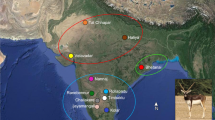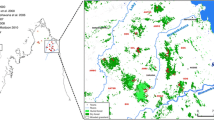Abstract
The raccoon dog, a medium-sized carnivore, has long been recognised as a prominent example of an invasive alien species in Europe with a wide distribution, significant ecological impact and remarkable dynamics of spread at both national and continental scales. We conducted a study of genetic diversity of 73 individuals collected at 20 sites across North and Central Europe to (1) identify major phylogenetic lineages and (2) elucidate spatial patterns of population genetic structure. Reconstructed phylogenies reveal two major clades differing on average by Tamura–Nei corrected distance of 3.4% for a 599-bp segment of the mitochondrial control region corresponding to a coalescence time of approximately 457,800 years ago (95% CI, 223,300–773,900). Many expectations based on introduction history, such as the presence of signatures of repeated founder effects and subsequently rapid population expansion, were not confirmed by our demographic analyses, probably due to an insufficient amount of time since translocations. Nevertheless, global F ST = 13.9% and landscape approaches provided evidence for weak population genetic structure that followed a pattern of isolation by distance. Finally, we found no congruence between previously reported morphological differentiation and the sorting of mtDNA variation. We therefore conclude that an exceptional combination of factors including multiple translocations, secondary contact and admixture of divergent matrilineages, as well as natural processes of colonisation associated with a wide ecological tolerance, promoted the successful spread of the raccoon dog into Europe.




Similar content being viewed by others
References
Allendorf FW, Lundquist LL (2003) Introduction: population biology, evolution, and control of invasive species. Conserv Biol 17:24–30. doi:10.1046/j.1523-1739.2003.02365.x
Altschul SF, Gish W, Miller W, Myers EW, Lipman DJ (1990) Basic local alignment search tool. J Mol Biol 215:403–410
Ansorge H, Ranyuk M, Kauhala K, Kowalczyk R, Stier N (2009) Raccoon dog, Nyctereutes procyonoides, populations in the area of origin and in colonised regions—the epigenetic variability of an immigrant. Ann Zool Fenn 46:51–62
Avise JC (2000) Phylogeography: the history and formation of species. Harvard University Press, Cambridge
Ayala FJ (1999) Molecular clock mirages. Bioessays 21:71–75. doi:1002/(SICI)1521-1878(199901)21:1<71::AID-BIES9>3.0.CO;2-B
Barbu P (1972) Beiträge zum Studium des Marderhundes, Nyctereutes procyonoides ussuriensis Matschie, 1907, aus dem Donaudelta. Säugetierkdl Mitt 20:375–405
Bjornerfeldt S, Webster MT, Vila C (2006) Relaxation of selective constraint on dog mitochondrial DNA following domestication. Genome Res 16(8):990–994. doi:10.1101/gr.5117706
Castric V, Bernatchez L (2003) The rise and fall of isolation by distance in the anadromous brook charr (Salvelinus fontinalis Mitchill). Genetics 163:983–996
Cirovic D (2006) First record of the raccoon dog (Nyctereutes procyonoides Gray, 1834) in the former Yugoslav Republic of Macedonia. Eur J Wildl Res 52:136–137. doi:10.1007/s10344-005-0106-z
Clark SA, Richardson BJ (2002) Spatial analysis of genetic variation as a rapid assessment tool in the conservation management of narrow-range endemics. Invertebr Syst 16:583–587. doi:10.1071/IT01041
Clavero M, Garcia-Berthou E (2005) Invasive species are a leading cause of animal extinction. Trends Ecol Evol 20:110. doi:10.1016/j.tree.2005.01.003
Dermitzakis MD, Van Der Geer AAE, Lyras GA (2004) The phylogenetic position of raccoon dogs: implications of their neuroanatomy. 5th International Symposium on Eastern Mediterranean Geology Thessaloniki, Greece, 14–20 April
Deutscher Jagdschutzverband (2009) Jahresstrecken Neozoen. Accessible at http://www.jagdschutzverband.de/datenfakten/jahresstrecken/?meta_id=257
Diniz-Filho JAF, Telles MPDC (2002) Spatial autocorrelation analysis and the identification of operational units for conservation in continuous populations. Conserv Biol 16:924–935
Drygala F, Stier N, Zoller H, Boegelsack K, Mix HM, Roth M (2008) Habitat use of the raccoon dog (Nyctereutes procyonoides) in north-eastern Germany. Mamm Biol 73:371–378
Ellstrand NC, Schierenbeck KA (2000) Hybridization as a stimulus for the evolution of invasiveness in plants? Proc Natl Acad Sci U S A 97:7043–7050
Excoffier L, Smouse PE, Quattro JM (1992) Analysis of molecular variance inferred from metric distances among DNA haplotypes: application to human mitochondrial DNA restriction data. Genetics 131:479–491
Excoffier L, Laval G, Schneider S (2005) Arlequin, version 3.0: an integrated software package for population genetics data analysis. Evol Bioinform Online 1:47–50
Felsenstein J (1985) Confidence limits on phylogenies: an approach using the bootstrap. Evolution 39:783–791
Frankham R (2005) Resolving the genetic paradox in invasive species. Heredity 94:385
Fu YX (1997) Statistical tests of neutrality of mutations against population growth, hitchhiking and background selection. Genetics 147:915–925
Fu YX, Li WH (1993) Statistical tests of neutrality of mutations. Genetics 133:693–709
Gaubert P, Godoy JA, del Cerro I, Palomares F (2009) Early phases of a successful invasion: mitochondrial phylogeography of the common genet (Genetta genetta) within the Mediterranean Basin. Biol Invasions 11:523–546
Harpending HC (1994) Signature of ancient population growth in a low-resolution mitochondrial DNA mismatch distribution. Hum Biol 66:591–601
Hassan M, Bonhomme F (2005) No reduction in neutral variation of mitochondrial and nuclear genes for a Lessepsian migrant, Upeneus moluccensis. J Fish Biol 66:865–870
Haubold B, Wiehe T (2001) Statistics of divergence times. Mol Biol Evol 18(7):1157–1160
Helle E, Kauhala K (1991) Distribution history and present status of the raccoon dog in Finland. Holarct Ecol 14:278–286
Hewitt G (2000) The genetic legacy of the quaternary ice ages. Nature 405:907–913
Hillis DM, Mable BK, Moritz C (1996) Applications of molecular systematics: the state of the field and a look to the future. In: Hillis DM, Moritz C, Mable BK (eds) Molecular systematics. Sinauer, Sunderland, MA, pp 515–543
Hudson RR (1990) Gene genealogies and the coalescent process. In: Futuyma DJ, Antonovics JD (eds) Oxford surveys in evolutionary biology. Oxford University Press, New York, pp 1–44
Kauhala K (1996) Introduced carnivores in Europe with special reference to central and northern Europe. Wildlife Biol 2:197–204
Kauhala K, Saeki M (2004) Raccoon dogs. In: Sillero-Zubiri C, Hoffmann M, Macdonald DW (eds) Canids: foxes, wolves, jackals and dogs. Status Survey and Conservation Action Plan IUCN/SSC Canid Specialist Group, Gland, Cambridge, pp 136–142
Kingman JFC (1982) On the Genealogy of Large Populations. J Appl Prob 19A:27–43
Kolbe JJ, Glor RE, Rodriguez Schettino L, Lara AC, Larson A (2004) Genetic variation increases during biological invasion by a Cuban lizard. Nature 431:177–181
Lapini L (2006) Il Cane viverrino Nyctereutes procyonoides ussuriensis Matschie, 1908 in Italia : Segnalazioni 1980–2005 (Mammalia: Carnivora: Canidae). Boll Mus civ Stor nat Ven 57:235–239 (in Italian)
Lavrov NP (1971) The results of the introductions of the raccoon dog (Nyctereutes procyonoides) in different provinces in the USSR. Trudy kafedry biologii Moskovskij Gosvdarstvennij Zaocnij Pedagogiceskij Institut 29:101–160 (in Russian)
Lee CE (2002) Evolutionary genetics of invasive species. Trends Ecol Evol 17:386–391
Lutz W (1989) Zum Vorkommen des Marderhundes (Nyctereutes procyonoides GRAY 1834) in Deutschland. Drosera 89(1/2):79–83 (in German with English summary)
Mantel N (1967) The detection of disease clustering and a generalized regression approach. Cancer Res 27:209–220
Marshall CR (1990) The fossil record and estimating divergence times between lineages: maximum divergence times and the importance of reliable phylogenies. J Mol Evol 30:400–408
Miller MP (2005) Alleles in space (AIS): computer software for the joint analysis of interindividual spatial and genetic Information. J Heredity 96:722–724
Mitchell-Jones AJ, Amori G, Bogdanowicz W, Kryðtufek B, Reijnders PJ H, Spitzenberger F, Stubbe M, Thissen JBM, Vohralik V, Zima J (1999) Atlas of European mammals. Academic, London
Morozov VF (1953) Akklimatizacija ussurskogo enota (Nyctereutes procyonoides, GRAY) kakprimer uspešnogo preobrazovanija fauny pušcnych sverej evropejskoj territorii SSSR. Zool Z 23:524–533
Nowak E (1973) Ansiedlung und Ausbreitung des Marderhundes (Nyctereutes procyonoides GRAY) in Europa. Beitr Jagd-und Wildforschung 8:351–384
Nowak E (1984) Verbreitungs-und Bestandsentwicklung des Marderhunds, Nyctereutes procyonoides (GRAY, 1834) in Europe. Range and population growth of the raccoon dogs in Europe. Z Jadgwiss 30:137–154
Nowak E (1993) Nyctereutes procyonoides (Gray, 1834)—Marderhund. In: Stubbe M, Krapp F (eds) Handbuch der Säugetiere Europas, vol 5/1. Aula, Wiesbaden, pp 215–248
Nowak E, Pielowski Z (1964) Die Verbreitung des Marderhundes in Polen im Zusammenhang mit seiner Einbürgerung und Ausbreitung in Europa. Acta Theriol 9:81–110
Okumura N, Ishiguro N, Nakano M, Matsui A, Sahara M (1996) Intra- and interbreed genetic variations of mitochondrial DNA major non-coding regions in Japanese native dog breeds (Canis familiaris). Anim Genet 27(6):397–405
Palumbi SR, Martin A, Romano S, McMillan WO, Grabowski G (1991) The simple fool's guide to PCR, version 2.0. University of Hawaii, Honolulu, Hawaii
Perry WL, Feder JL, Dwyer G, Lodge DM (2001) Hybrid zone dynamics and species replacement between Orconectes crayfishes in a northern Wisconsin lake. Evolution 55:1153–1166
Pitra C, Rehbein S, Lutz W (2005) Tracing the genetic roots of the sika deer Cervus nippon naturalized in Germany and Austria. Eur J Wildl Res 51:237–241
Posada D, Crandall KA (1998) Modeltest: testing the model of DNA substitution. Bioinformatics 14:817–818
Prokopenko AA, Williams DF, Kuzmin MI, Karabanov EB, Khursevich GK, Peck JA (2002) Muted climate variations in continental Siberia during the mid-Pleistocene epoch. Nature 418:65–68
Rafinski J, Babik W (2000) Genetic differentiation among northern and southern populations of the moor frog Rana arvalis Nilsson in central Europe. Heredity 84:610–618
Ralli UM, Kritskaya TI (1953) Erfahrungen über die Akklimatisierung des ussurischen Marderhundes im Gebiet von Rostow. Essai d'acclimation du chien viverrin dans la region de Rostov. An experiment in acclimation of Usurri raccoon dog in the Rostov region. Zool Zhurn 32:513–522 (in Russian)
Ramos-Onsins SE, Rozas J (2002) Statistical properties of new neutrality tests against population growth. Mol Biol Evol 19:2092–2100
Reed DH, Frankham R (2001) How closely correlated are molecular and quantitative measures of genetic variation? A meta-analysis. Evolution 55:11095–1103
Rogers AR, Harpending H (1992) Population growth makes waves in the distribution of pairwise genetic differences. Mol Biol Evol 9:552–569
Rozas J, Sánchez-DelBarrio JC, Messegyer X (2003) DnaSP, DNA polymorphism analyses by the coalescent and other methods. Bioinformatics 19:2496–2497
Sakai AK, Allendorf FW, Holt JS, Lodge DM, Molofsky J, Kimberly A, Syndallas B, Cabin RJ, Cohen JE, Ellstrand NC, McCauley DE, O'Neil P, Parker IM, Thompson JN, Weller SG (2001) The population biology of invasive species. Annu Rev Ecol Syst 32:305–332
Sax DF, Brown JH (2000) The paradox of invasion. Glob Ecol Biogeogr 9:363–371
Schwarz S, Sutor A, Pitra C (2004) Raccon dogs—silently colonizing Europe (Nyctereutes procynoides GRAY 1834). Proceedings volume, Neobiota Conference, Bern
Sheldon J (1992) Wild dogs: the natural history of the nondomestic Canidae. Academic, San Diego
Slatkin M (1993) Isolation by distance in equilibrium and non-equilibrium populations. Evolution 47:264–279
Sokal RR, Oden NL (1978) Spatial autocorrelation analysis in biology 2. Some biological implications and four applications of evolutionary and ecological interest. Biol J Linn Soc 10:229–249
Sutor A (2008) Dispersal of the alien raccoon dog Nyctereutes procyonoides in Southern Brandenburg, Germany. Eur J Wildl Res 54:321–326
Swofford DL (2001) PAUP*: phylogenetic analysis using parsimony (* and other methods), version 4.0. Sinauer, Sunderland, MA
Tajima F (1989) The effect of change in population size on DNA polymorphism. Genetics 123:597–601
Tajima D, Tajima F (1989) Statistical method for testing the neutral mutation hypothesis by DNA polymorphism. Genetics 123:585–595
Tamura K, Nei M (1993) Estimation of the number of nucleotide substitutions in the control region of mitochondrial DNA in humans and chimpanzees. Mol Biol Evol 10:512–526
Tedford RH, Qiu Z (1991) Pliocene Nyctereutes (Carnivora: Canidae) from Yushe, Shanxi, with comments on Chinese fossil raccoon-dogs. Vertebrata PalAsiatica 29:179–189
Vilà C, Savolainen P, Maldonado JE, Amorim IR, Rice JE, Honeycutt RL, Crandall KA, Lundeberg J, Wayne RK (1997) Multiple and ancient origins of the domestic dog. Science 276:1687–1689
Ward OG, Wurster-Hill DH (1990) Mammalian species: Nyctereutes procyonoides. American Society of Mammalogists, no. 358, pp 1–5
Ward OG, Wurster-Hill DH, Ratty FJ, Strong Y (1987) Comparative cytogenetics of Chinese and Japanese raccoon dogs, Nyctereutes procyonoides. Cytogenet Cell Genet 45:177–186
Wayne RK (1993) Molecular evolution of the dog family. Trends Genet 9:218–224
Weber E (2003) Invasive plant species of the world a reference guide to environmental weeds. CABI, Wallingford
Zink RM, Pavlova A, Rohwer S, Drovetski SV (2006) Barn swallows before barns: population histories and intercontinental colonization. Proc R Soc B 273:1245–1251
Acknowledgements
We gratefully thank the following persons for collecting tissue samples of raccoon dogs: Dr. H. Ansorge, Dr. M. Bartoszewicz, Dr. P. Borkenhagen, A. Brauer, Dr. M. Heltai, Dr. B. Herzig, Dr. K . Kauhala, R. Kögel, B. Meyer, A. M. Mustonen, E. Puchinger, T. Randvur, W. Schuster, A. Sutor, Dr. J. M. Weber, S. Werner, K. Zwonarz. We thank Anke Schmidt for technical assistance.
Author information
Authors and Affiliations
Corresponding author
Additional information
Communicated by W. Lutz
Rights and permissions
About this article
Cite this article
Pitra, C., Schwarz, S. & Fickel, J. Going west—invasion genetics of the alien raccoon dog Nyctereutes procynoides in Europe. Eur J Wildl Res 56, 117–129 (2010). https://doi.org/10.1007/s10344-009-0283-2
Received:
Accepted:
Published:
Issue Date:
DOI: https://doi.org/10.1007/s10344-009-0283-2




